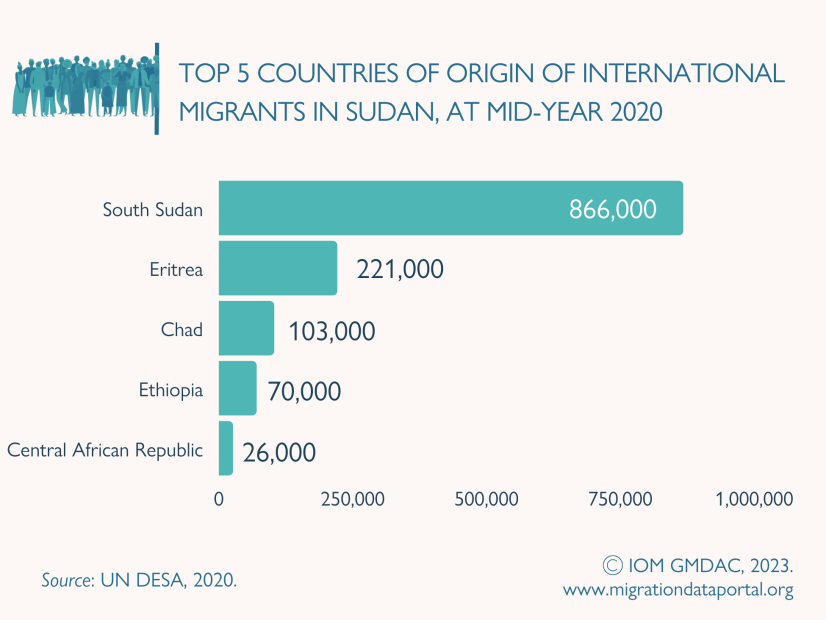
The current conflict adds to an already precarious humanitarian situation for many people in Sudan. Due to the conflict, many people within the country are becoming newly internally displaced, others are crossing the border to neighbouring countries, including Sudanese refugees, returnees or third-country-nationals.

Displacement within and from Sudan
Pre-conflict, a total of 836,756 refugees were from Sudan (as of end year 2022). Nearly 95 per cent of them were hosted in five countries: Chad (48%), South Sudan (35%), Ethiopia (6%), Egypt (3%) and France (3%) (GMDAC analysis of UNHCR, 2023).
As of end 2022, Sudan hosted one of the largest refugee populations in Africa. Among the nearly 1.1 million refugees hosted in Sudan, more than 99 per cent were from five countries: South Sudan (73%), Eritrea (11%), Syrian Arab Republic (9%), Ethiopia (5%) and the Central African Republic (2%) (GMDAC analysis of UNHCR, 2023).
Pre-conflict, IOM’s Displacement Tracking Matrix (DTM) Sudan projected that Sudan had 3.8 million IDPs, the vast majority of whom (an estimated 79%) were based in Darfur and in desperate need of humanitarian aid (Revised HRP, 2023; DTM, 2022). In 2022, Sudan reportedly had the highest number of internal displacements due to conflict and violence in the region*[1] (IDMC, 2023).
Sudan: A popular destination and transit country for international migrants
At mid-year 2020, an estimated 1.4 million migrants resided in Sudan and they made up 3 per cent of the total population. Of these, female migrants accounted for 50 per cent, and this share is slightly higher than the global share of 48 per cent (GMDAC analysis of UN DESA, 2020). Child migrants accounted for nearly 44 per cent of all migrants hosted in Sudan in 2020, and this share is significantly higher than the global share of child migrants (13%). In absolute terms, Sudan was the African country with the second highest number of child migrants (GMDAC analysis of UNICEF, 2021). Nearly 98 per cent of the migrants in Sudan were from African countries, and 91 per cent were from four neighbouring countries of origin: South Sudan (63%), Eritrea (16%), Chad (7%) and Ethiopia (5%) (GMDAC analysis of UN DESA, 2022). The highest value of international migrants in Northern Africa was in Sudan (UN DESA, 2020). Newer estimates by IOM’s Displacement Tracking Matrix suggest that 775,570 foreign nationals lived in Sudan as of March 2023[2] (DTM, 2022).
However, the actual number of international migrants transiting or residing in Sudan is believed to be much higher (HNO, 2022). The current conflict negatively impacts migrant workers in the country, particularly those who rely e.g. on seasonal agricultural jobs or work in the oil industry (Mixed Migration Center, 2023).The country also serves as an important transit point for migrants from the region in search of better economic opportunities with many using the Eastern Route to Yemen onwards to Saudi Arabia or the Northern Route to Libya (Mixed Migration Center, 2023; IOM, 2023). For many, the primary drivers of migration to countries such as Libya are economic factors and the pursuit of a better livelihood. Around 89 per cent of the 706,062 migrants in Libya stated that economic difficulties, such as limited job prospects or inadequate income in their home countries, were one of the main reasons for their decision to come to Libya (IOM, 2023). As of February 2023, over 133,000 Sudanese migrants resided in Libya (ibid).
En route, cities like Khartoum serve as important transit hubs for migrants on the move. Many often have an irregular status and are economically and socially vulnerable with no access to public services such as healthcare and education for children and are working in the informal economy for daily wages. The country has also increasingly become a transit point for traffickers who smuggle and/or traffic young Ethiopian female migrants via Sudan en route to the Middle East (HNO, 2022).
Sudanese emigrants
Globally, an estimated 2.1 million Sudanese migrants lived outside their home country as of mid-year 2020. Female emigrants accounted for nearly 45 per cent of all Sudanese emigrants, and this share is lower than the global share of 48 per cent (GMDAC analysis of UN DESA, 2022). Of the estimated 2.1 million Sudanese emigrants, nearly 56 per cent of them resided in Africa and another 36 per cent in Asia (specifically, Western Asia). The top two destination countries – South Sudan and Saudi Arabia – together hosted more than half of all Sudanese emigrants. Other major destination countries were Chad (18%), the United Arab Emirates (6%) and Uganda (3%) (ibid.).
The Sudanese diaspora plays an important role in contributing financially to their country of origin. In 2022, an estimated USD 1.5 billion in remittances were received in Sudan. In terms of remittance outflows, an estimated USD 247 million were sent from Sudan in 2022 (KNOMAD/World Bank, 2023).
Transhumance, pastoral communities and seasonal migrants
Pastoralism in Sudan remains a traditional way of life and pastoral communities rely on migration in search of pastures and water, whether through transhumance (fixed pattern of movement) or nomadic pastoralism (irregular patterns of movement). The agricultural industry, which accounts for one-third of the country's GDP and employs more than half of all workers, many of whom are from pastoralist communities, plays an important role for Sudanese economy (World Bank, 2020). Additionally, the pastoral sector creates jobs for seasonal workers and supports local markets (Krätli et al., 2013).

